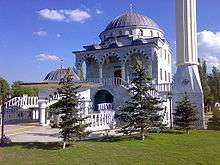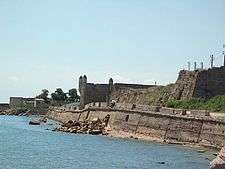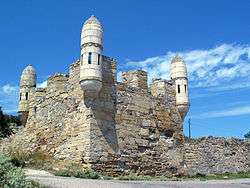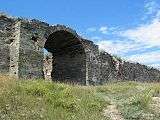Turks in Ukraine
Turks in Ukraine are people of Turkish ethnicity living in Ukraine. The community is largely made of Meskhetian Turks and immigrants from Turkey.
| Total population | |
|---|---|
| 8,844 (2001 census)[1] 10,000 Meskhetian Turks (academic estimates)[2][3][4] plus 5,394 Turkish nationals (2009)[5] | |
| Regions with significant populations | |
| 3,736 | |
| 1,791 | |
| 969 | |
| 758 | |
| Languages | |
| Turkish (89.6%) | |
| Religion | |
| Islam, Christianity | |
History
Ottoman migration
The First All-Union Census of the Soviet Union in 1926 recorded 8,570 Ottoman Turks living in the Soviet Union. The Ottoman Turks are no longer listed separately in the census, it is presumed that those who were living in Ukraine have either been assimilated into Ukrainian society or have left the country.[6]
Meskhetian Turks migration
| Meskhetian Turks in Ukraine according to official Census' | |||||||
| Census | Turks | ||||||
|---|---|---|---|---|---|---|---|
| 1939[7] | 853 | ||||||
| 1959[8] | 284 | ||||||
| 1970[9] | 226 | ||||||
| 1979[10] | 257 | ||||||
| 1989[11] | 262 | ||||||
| 2001[1] | 8,844 | ||||||
The Meskhetian Turks first arrived in Ukraine after World War II when the Soviet Union was preparing to launch a pressure campaign against Turkey. Vyacheslav Molotov, then Minister of Foreign Affairs, demanded the surrender of three Anatolian provinces (Kars, Ardahan and Artvin); thus, war against Turkey seemed possible, and Joseph Stalin wanted to clear the strategic Turkish population situated in Meskheti, located near the Turkish-Georgian border which were likely to be hostile to Soviet intentions.[12] In 1944, the Meskhetian Turks were forcefully deported from the Meskheti region in Georgia and accused of smuggling, banditry and espionage in collaboration with their kin across the Turkish border.[13] Nationalistic policies at the time encouraged the slogan: "Georgia for Georgians" and that the Meskhetian Turks should be sent to Turkey "where they belong".[14][15] Although Joseph Stalin deported the majority of Meskhetian Turks to Uzbekistan, thousands dying en route in cattle-trucks,[16] in 1989, the Meskhetian Turks living in Uzbekistan became the victims of riots by the ethnic Uzbeks.[17] Thus, the majority of the Meskhetian Turkish community arrived in Ukraine during 1989-1990 following ethnic persecution in the Ferghana Valley in Uzbekistan; most others immigrated later to re-unite with their relatives.[2]
Approximately 10,000 Meskhetian Turks live in Ukraine.[18] The majority of the Meskhetian Turkish community arrived in Ukraine during 1989-1990 following ethnic persecution in the Ferghana Valley in Uzbekistan; most others immigrated later to re-unite with their relatives. They are concentrated mostly in Crimea, Donetsk, Kherson, and Mykolaiv. A few live in Kiev. Most settled in Ukraine following the Fergana events. In 1991, they were granted Ukrainian citizenship.
Meskhetian Turks are Sunni Muslims. Due to the Soviet Union’s official policy of discouraging religion and promoting atheism, the majority of Meskhetian Turks, like Albanian Muslims, are not strictly observant Muslims.
Demographics
According to the 2001 Ukrainian Census there was 8,844 Turks living in Ukraine.[1] The majority of the community was living in Kherson (3,736), Donetsk (1,791), Crimea (969) and Mykolaiv Oblast (758).[1]
Religion
A Mosque was also built in Mariupol, Ukraine and named after Suleiman the Magnificent, the Mosque was opened in 2005. It was built by a Turkish Businessman (Salih Cihan). Five times prayers along with the Friday Prayers are offered at the mosque.
Education
The Simferopol International School opened by Turkish entrepreneurs in the Autonomous Republic of Crimea in Ukraine has been listed the top school in the list of the country’s best 100 schools. Turkish, English, Crimean Tatar, and French are taught at the school. In the third year since its establishment, the school has achieved several successes in the Olympics held in the city and across the country. The Turkish school also won a bronze medal in the International Environmental Project Olympics (INEPO) held in Turkey.[19] Turkish Parliament Speaker of the time, Cemil Cicek had visited Meridian International School founded by Turkish entrepreneurs in Ukrainian capital Kiev on April 4, 2013.[20]
Notable Turks in Ukraine
Gallery
Ottoman architecture in Ukraine
See also
References
- State Statistics Service of Ukraine. "Ukrainian Census (2001):The distribution of the population by nationality and mother tongue". Archived from the original on 2004-11-24. Retrieved 2012-01-16.
- Pentikäinen & Trier 2004, 20.
- Aydıngün et al. 2006, 14.
- Council of Europe 2006, 23.
- Çalışma ve Sosyal Güvenlik Bakanlığı. "YURTDIŞINDAKİ VATANDAŞLARIMIZLA İLGİLİ SAYISAL BİLGİLER (31.12.2009 tarihi itibarıyla)". Archived from the original on 2012-03-10. Retrieved 2011-09-27.
- Akiner 1983, 381.
- Демоскоп Weekly. "Всесоюзная перепись населения 1939 года. Национальный состав населения по республикам СССР". Retrieved 2012-01-19.
- Демоскоп Weekly. "Всесоюзная перепись населения 1959 года. Национальный состав населения по республикам СССР". Retrieved 2012-01-19.
- Демоскоп Weekly. "Всесоюзная перепись населения 1970 года. Национальный состав населения по республикам СССР". Retrieved 2012-01-19.
- Демоскоп Weekly. "Всесоюзная перепись населения 1979 года. Национальный состав населения по республикам СССР". Retrieved 2012-01-19.
- Демоскоп Weekly. "Всесоюзная перепись населения 1989 года. Национальный состав населения по республикам СССР". Retrieved 2012-01-19.
- Bennigsen & Broxup 1983, 30.
- Tomlinson 2005, 107.
- Kurbanov & Kurbanov 1995, 237.
- Cornell 2001, 183.
- Minority Rights Group International. "Meskhetian Turks". Archived from the original on 2009-04-29. Retrieved 2011-06-02.
- Ryazantsev 2009, 167.
- http://hoglentatum.narod.ru/
- "Turkish School Awarded 'Ukraine's Best School'". Retrieved 2014-10-24.
- Hizmet Movement blog (2013-04-06). "Parliament Speaker Cicek visits Turkish School in Kiev". Retrieved 2014-10-20.
Bibliography
- Akiner, Shirin (1983), Islamic Peoples of the Soviet Union, Taylor & Francis, ISBN 0-7103-0025-5.
- Aydıngün, Ayşegül; Harding, Çigğdem Balım; Hoover, Matthew; Kuznetsov, Igor; Swerdlow, Steve (2006), Meskhetian Turks: An Introduction to their History, Culture, and Resettelment Experiences (PDF), Center for Applied Linguistics, archived from the original (PDF) on 2007-07-14
- Bennigsen, Alexandre; Broxup, Marie (1983), The Islamic threat to the Soviet state, Taylor & Francis, ISBN 0-7099-0619-6.
- Cornell, Svante E. (2001), Small nations and great powers: a study of ethnopolitical conflict in the Caucasus, Routledge, ISBN 0-7007-1162-7.
- Council of Europe (2006), Documents: working papers, 2005 ordinary session (second part), 25-29 April 2005, Vol. 3: Documents 10407, 10449-10533, Council of Europe, ISBN 92-871-5754-5.
- Kurbanov, Rafik Osman-Ogly; Kurbanov, Erjan Rafik-Ogly (1995), "Religion and Politics in the Caucasus", in Bourdeaux, Michael (ed.), The Politics of Religion in Russia and the New States of Eurasia, M.E. Sharpe, ISBN 1-56324-357-1.
- Pentikäinen, Oskari; Trier, Tom (2004), Between Integration and Resettlement: The Meskhetian Turks, European Centre For Minority Issues
- Ryazantsev, Sergey V. (2009), "Turkish Communities in the Russian Federation" (PDF), International Journal on Multicultural Societies, 11 (2): 155–173
- Tomlinson, Kathryn (2005), "Living Yesterday in Today and Tomorrow: Meskhetian Turks in Southern Russia", in Crossley, James G.; Karner, Christian (eds.), Writing History, Constructing Religion, Ashgate Publishing, ISBN 0-7546-5183-5.



